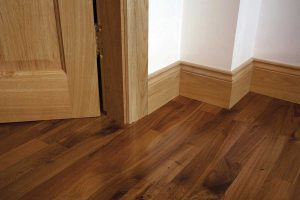Wood finishes include paint, varnish, oil and wax. Varnish coats the wood with a durable, hard finish while oil penetrates the wood. Wax is in many ways an in-between in that it both coats and penetrates but to a lesser extent than oil.
Oil and wax are often used in combination. Paints come in a wider range of colours and applications, from floor paint to scrubable emulsions for walls that attract sticky fingers. With all finishes, be mindful that there will be upkeep in that you will need to reapply your chosen finish on a regular basis to keep it looking fresh.
Wax generally requires a yearly application, for instance, straight onto the (cleaned) surface, while other finishes require a light sanding before the refresher coat is applied.
Be mindful that wood finishes will not hide blemishes or uneven patches, it’s therefore vital to prepare your surface as much as possible before you reach for the brush: clean it first, then fill gaps if necessary, and finally sand down as smooth as you can.
Applications
Varnish is often used for high impact areas such as floors or table tops that will get some abuse over the years. However as varnish provides a top coat, in bathrooms and kitchens moisture or water could penetrate beneath it and then find it difficult to escape. So while varnish can easily handle spillages, oil is much more efficient in situations where you need a consistently water repellent surface.
[adrotate banner="58"]You will however need to apply as many oil coats as you can before installation, and keep coating the worktop as you use it to ensure the wood gets fully saturated. If you are staining your floor, know that you can get oils with stain – using a stain on its own requires great care to ensure an even application, especially indoors, and having oil as a carrying agent helps achieve this.
For a smaller scale project, staining then coating with varnish can work equally well. If you’re using MDF or similar sheet material, know that it can be quite absorbent which can lead to a patchy finish if not prepared properly. It should be sealed first with a sealant or primer before any colour is applied.
MDF primers are available but any primer should do. Make sure you prime the edges well as these are the most absorbent and will swallow your paint or varnish.
Before you start
The two most important things with finishing wood is to ensure its moisture content is adequate (around 10 per cent for centrally heated room) and that you’ve sanded it down with 240 grit or finer sandpaper to get a smooth finish.
‘With all finishes, be mindful that there will be upkeep in that you will need to reapply your chosen finish on a regular basis…’
If you are using recently felled timber – knots are more common in softwoods such as pine – apply a knotting solution made of natural resin that will seal them by preventing the sap from seeping out. Knots occur where branches were connected to the tree. If you paint, stain or varnish over a knot without first treating it, you could end up with a stain seeping through and looking very unsightly. A yellow stain will appear on a white paint job. Another way of dealing with a large knot is to remove it with a router, a drill or carefully chisel it out and set a piece in. This is normally done on high quality furniture or where the strength of the timber is in question.








